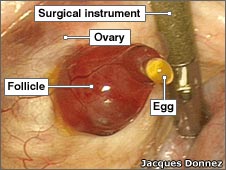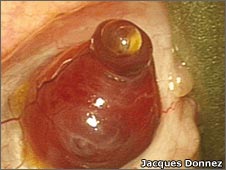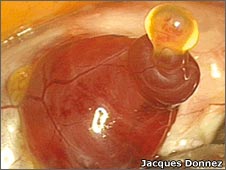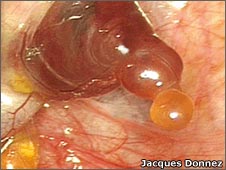For the first time, the image of ovulation is recorded
Scientists have captured a close-up image of a human egg falling out of an ovary, completely coincidentally during a normal operation.
Usually women lose an egg every month, but so far, it has been recorded in detail about this process in animals. And gynecologist Jacques Donnez at the Catholic University in Louvain, Belgium, was the first to witness this process during an operation to remove the womb on a 45-year-old Belgian woman.
Human eggs are made from follicles. These are bags filled with fluid in the ovary. When the time is right for ovulation, the follicle will protrude a dark red lump. The egg will come out from here, covered with a layer of plastic containing cells.


Ovulation takes place in the ovary's tissue.
The process is recorded in detail for the first time.


The egg comes out from a follicle in the ovary.
After getting out, it will go down the fallopian tube to wait for fertilization.
In humans, each egg is only as big as a dot, and the entire ovary is only about 5 cm long.
Dr Donnez said the photos could help scientists better understand the mechanism of ovulation. Earlier, some theories suggested that the process took place in a booming manner, but according to what he witnessed, the whole event took place within 15 minutes.
"It is interesting to see the image of ovulation, to see it in real life is a very rare case," said Professor Alan McNeilly at the Commission on Human Reproduction in Edinburgh, England, said. "It is a key part of the whole process, a beginning of life in some way."
- Interesting facts about ovulation days in women
- Calculate the date of ovulation when menstruation is irregular
- Why are elephants pregnant for nearly 2 years?
- Pregnant women are very good at detecting snakes
- The first time the film was recorded
- Korea announced the image of Earth taken from space
- The first 3D animal fetus image
- New discoveries about sex
- Revealing the image of the Sun when destroyed
- For the first time, capture the 4th level rainbow image in the sky
- Video: UFO rushes down to the crater
- Dolphins also kill fellow species for entertainment
 Why do potatoes have eyes?
Why do potatoes have eyes? 'Tragedy' the world's largest carnivorous life: Death becomes ... public toilet
'Tragedy' the world's largest carnivorous life: Death becomes ... public toilet Tomatoes were once considered 'poisonous' for 200 years
Tomatoes were once considered 'poisonous' for 200 years Detecting microscopic parasites on human face
Detecting microscopic parasites on human face